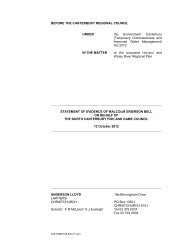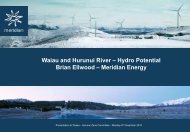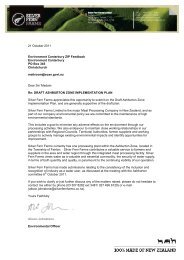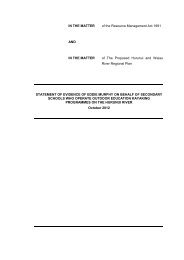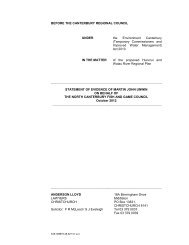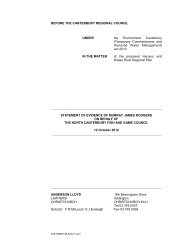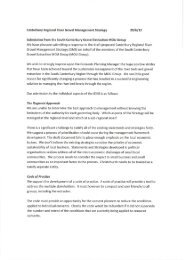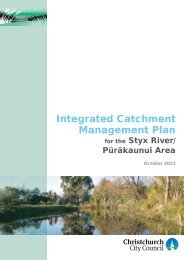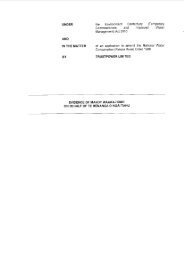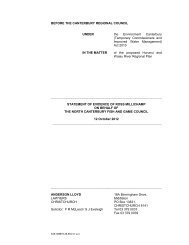Geological contours for groundwater modelling, South Canterbury
Geological contours for groundwater modelling, South Canterbury
Geological contours for groundwater modelling, South Canterbury
Create successful ePaper yourself
Turn your PDF publications into a flip-book with our unique Google optimized e-Paper software.
20121.0 INTRODUCTIONGroundwater is an important resource in <strong>South</strong> <strong>Canterbury</strong> and the management of<strong>groundwater</strong> resources is aided by knowledge of the nature and distribution of geological<strong>for</strong>mations. The geological <strong>for</strong>mations of <strong>South</strong> <strong>Canterbury</strong> comprise a distinctive set oflayers (strata) which may conveniently be grouped within three categories, from oldest toyoungest; basement rock, Cretaceous-Cenozoic rocks and Quaternary sediments. Basementrock <strong>for</strong>ms the undermass of the region, and is dominated by hard sandstone (greywacke)and mudstone (argillite), in places metamorphosed to semischist. Covering the basementrock are Cretaceous-Cenozoic rocks, comprising a ‘layer-cake’ of deposits totalling morethan 1 km thick in eastern <strong>South</strong> <strong>Canterbury</strong>, including soft quartz sandstones andmudstones, a distinctive limestone band in the middle of the sequence, and greywackederivedmuds, sands and gravels towards the top of the sequence, which near Timaru andGeraldine are capped by a layer of basaltic volcanic rock. Quaternary sediments aredominated by river gravels and sands, and include the windblown loess that drapes much ofthe terraced and rolling lowland terrain. During the late Cenozoic, tectonic <strong>for</strong>ces have led tofolding, faulting and localised uplift in <strong>South</strong> <strong>Canterbury</strong>. In uplifted areas, erosion hasdissected or removed the cover rocks, exposing the basement rock. Only the <strong>Canterbury</strong>Plains have remained largely unaffected by uplift. A more detailed outline of the geologicalorigins of <strong>South</strong> <strong>Canterbury</strong> is provided by Barrell (2008) and references therein.<strong>Geological</strong> maps depict the distribution of geological layers at the ground surface, but do notprovide a direct picture of what lies deeper underground. A common way of definingsubsurface geological features is by means of structure <strong>contours</strong>, which are lines of equalelevation drawn on a two-dimensional (2D) geological feature, such as a boundary betweentwo geological layers. Structure <strong>contours</strong> are analogous to topographic <strong>contours</strong> on the landsurface, and usually are expressed in the same units, metres relative to sea level. Structure<strong>contours</strong> impart a third dimension to a 2D geological feature.The most important aquifers of <strong>South</strong> <strong>Canterbury</strong> are the Quaternary sediments, and also theKowai Formation, which is the name applied to greywacke-derived sands and gravels lyingnear the top of the Cretaceous-Cenozoic rock sequence. The top of the Kowai Formation,which includes gravel-dominated sediments widely known as ‘Cannington Gravel’,approximates the base of the Quaternary sediments beneath the <strong>Canterbury</strong> Plains.Elsewhere, Quaternary sediments rest uncon<strong>for</strong>mably on the Kowai or older <strong>for</strong>mations.The <strong>Canterbury</strong> Regional Council (Environment <strong>Canterbury</strong>) engaged the Institute of<strong>Geological</strong> and Nuclear Sciences Limited (GNS Science) to provide an interpretation, bymeans of structure <strong>contours</strong>, of the subsurface positions of the top and bottom of the KowaiFormation and the top of the basement rock across a wide tract of the eastern part of <strong>South</strong><strong>Canterbury</strong>, extending from near Geraldine to the Waitaki rivers and including theCannington/Fairlie basins inland as far as Burkes Pass (Fig. 1).The structure contour interpretation of the subsurface geometry of these geologicalboundaries is primarily intended as an input to a 3D <strong>groundwater</strong> model that thatEnvironment <strong>Canterbury</strong> proposes to build to assist <strong>groundwater</strong> management.GNS Science Consultancy Report 2012/245 1
20122.0 INFORMATION SOURCESThe in<strong>for</strong>mation used in this assessment was:• Published geological maps from the GNS Science 1:250,000 ‘QMAP’ (Quartermillion-scalemap) series, Waitaki sheet (Forsyth 2001) and Aoraki sheet (Cox &Barrell 2007), as well as the underlying digital GIS databases (Figs. 2a, 2b);• Unpublished QMAP geological ‘record’ maps, comprising field observations and otherdetailed published geological in<strong>for</strong>mation hand-drawn onto 1:50,000 scaletopographic maps, held on file at the GNS Science Dunedin office;• Measurements of thicknesses of rock strata from geological exposures (‘measuredsections’) at various places around the region (Field et al. 1989). Indicative locations(some measured section lines extend <strong>for</strong> several kilometres) are shown in Fig. 3;• Topographic in<strong>for</strong>mation, in particular topographic <strong>contours</strong>, from Land In<strong>for</strong>mationNew Zealand digital map images and datasets;• Interpretations and evaluations from recent <strong>groundwater</strong> geology assessments in thestudy area by Forsyth (2004) and Barrell (2008);• In<strong>for</strong>mation from available bore hole records, particularly the Environment <strong>Canterbury</strong>bore hole database (see Fig. 3 <strong>for</strong> examples);• In<strong>for</strong>mation from geophysical surveys in the Cannington basin (Langdale & Stern1998) and lower Waitaki valley (Woodward et al. (2003).3.0 GEOLOGICAL CONTOURINGStructure <strong>contours</strong> were drawn on the basis of the in<strong>for</strong>mation sources outlined in Section2.0. The <strong>contours</strong> are a geological interpretation, based on weights of evidence from thevarious datasets, and in only a few places are constrained by direct observations. Theyrepresent a hypothesis as to the geometries of the targeted subsurface geologicalboundaries. It is anticipated that the contour models should be refined and improved upon inthe future as additional in<strong>for</strong>mation comes to hand, such as by the drilling of new bores.3.1 MethodologyThe most important inputs to the contouring are surface geological data from maps andmeasured sections, with ground surface elevations obtained from topographic map <strong>contours</strong>.Subsurface in<strong>for</strong>mation from bore holes and geophysical surveys, while valuable, has somelimitations. The bore hole dataset has three significant limitations. First, only some of thebores have records (logs) of the geological materials (lithologies) encountered during drilling.Second, the detail and reliability of lithological logs is highly variable; in many cases even ageological specialist may have difficulty in identifying specific geological <strong>for</strong>mations from borehole lithological logs (see discussion in Forsyth 2004). Third, most bores are relativelyshallow, rarely more than 100 m deep, whereas the geological <strong>for</strong>mation boundaries that areGNS Science Consultancy Report 2012/245 2
2012the topic of this project commonly extend to many hundreds of metres depth.A major limitation of geophysical data is that geophysical surveys have been undertaken atonly a few localised places in the project area, and furthermore, the results do notnecessarily allow definitive conclusions to be drawn about subsurface geology.The interface between hard basement rock and the softer and more varied Cretaceous-Cenozoic rocks is far and away the most easily recognisable geological boundary in theproject area. In most cases, it is easily distinguished in geological exposures, from contrastsin land<strong>for</strong>m character and in bore hole logs. Un<strong>for</strong>tunately, as is described in Section 3.1.2below, the same is not true of the Kowai Formation. It has a varied lithological character, andin many places is not distinctively different from the overlying and underlying <strong>for</strong>mations.In a project that was a precursor to the present project, Jongens (2011) produced a structurecontour model of the boundary between Quaternary sediments and underlying older<strong>for</strong>mations beneath the <strong>Canterbury</strong> Plains between the Ashley and Rakaia rivers. Thatproject benefited from an array of hydrocarbon-exploration seismic survey lines and severaldeep (>1 km) exploration bore holes. However, no subsurface in<strong>for</strong>mation of that density orquality is available in the area of the <strong>South</strong> <strong>Canterbury</strong> project reported here, and a differentmethodological strategy was there<strong>for</strong>e needed in order to achieve the aims of the project.The thicknesses of the Cretaceous-Cenozoic cover rock strata are well established at anumber of locations in the project area (measured sections; see Fig. 3 and Table 1).Although these thicknesses vary from place to place, they provide a good foundation <strong>for</strong>geological interpolation and extrapolation, and <strong>for</strong>m a major basis <strong>for</strong> the structure contourinterpretations presented in this report.The following sections outline the procedures used to define the structure <strong>contours</strong> <strong>for</strong> eachof the target geological features. Commentary on the reasoning behind aspects of thecontouring interpretations is provided in Appendix 1.3.2 Contouring the top of basement rockThe following approach was used to define <strong>contours</strong> on the top of the basement rock:• The position of the contact between the basement rock and overlying Cretaceous-Cenozoic rocks is mapped at numerous locations around the project area (see Fig.2a). In a few places the contact is directly exposed, but in many others its preciselocation is inferred with good confidence based on nearby rock exposures. Where amapped contact intersects a topographic contour defines a point on the structurecontour line corresponding to that topographic elevation. In other words, theintersection of a geological contact and a topographic contour directly pinpoints astructure contour. For a structure contour map of a particular geological feature, it isimportant to delineate the extent of the target feature, including where it lies at orabove ground (outcrop) as well as where it lies underground (subcrop) (Fig. 4).• Points (‘stratigraphic picks’; Fig. 3) were marked where distinctive geological strataboundaries intersect specific topographic <strong>contours</strong>. In the project area, the mostdistinctive geological stratum, apart from the contact between the basement rock andGNS Science Consultancy Report 2012/245 3
2012the overlying Cretaceous-Cenozoic rocks, is the Kekenodon Group limestone layer(eMk). An inherent asset of the hard limestone layer is that it commonly <strong>for</strong>ms rockyoutcrop, and so can be detected and located accurately in many places within theproject area.• At each stratigraphic pick on a distinctive stratum, we used measured sectionstratigraphic thickness estimates to calculate depth to basement beneath thatstratum, and assigned an elevation to the basement surface (metres relative to sealevel) based on the topographic contour value at the pick site. To illustrate with anexample, the limestone layer is semi-continuously exposed between Hanging Rockon the north bank of the Opuha River through to Kakahu Bush. Measured sectionin<strong>for</strong>mation indicates that in this general area, the top of the basement lies 400 mbelow the base of the limestone, and so where the base of the limestone crosses a100-m interval topographic contour, the stratigraphic pick is assigned an elevation ofthe top of the basement that is 400 m less than the elevation of that topographiccontour. In this way, numerous stratigraphic data picks were marked across theproject area, using a variety of distinctive stratigraphic boundaries (Fig. 3).• At each stratigraphic pick, we did not allow <strong>for</strong> the dip of the strata. Measuredstratigraphic sections are ‘true’ thicknesses, measured perpendicular to bedding. Truestratigraphic thickness equates to depth below the ground where the strata arehorizontal, but where strata are inclined, the vertical thickness is greater than the truethickness. However, <strong>for</strong> the most part, the strata of the project area are inclined atgentle (
2012relatively smooth, land<strong>for</strong>m surface. This erosion surface, sometimes called a‘peneplain’, is an approximation of the top of the basement, and where it is welldefinedwe drew <strong>contours</strong> on this topographic surface (Fig. 4). These erosion-surface<strong>contours</strong> help to define the structure and dip of the top-of-basement surface, and in anumber of places assisted in determining the most likely spacing of top-of-basement<strong>contours</strong> in adjacent parts of the subsurface.• In addition, there are places where erosion has removed the Cretaceous-Cenozoicrocks from the basement, and Quaternary sediments have subsequently been laiddown. As these Quaternary sediments are likely to be aquifers, we have drawn<strong>contours</strong> on the basement/Quaternary sediment interface in the main basin areaswhere this geological relationship dominates, notably near Burke Pass and nearAshwick Flat in the Fairlie basin (Fig. 4).• The primary geophysical data are four gravity survey transects across the Canningtonbasin by Langdale & Stern (1998), and one gravity transect in the lower Waitaki valley(Woodward et al. 2003). Similarly, using their resulting interpretations of depths tobasement, we drew ‘geophysical picks’ that were taken into account in the contouring.Where delineated in the gravity interpretation, we also drew picks on the base ofKowai Formation. However, these picks were given little weight in the contouringbecause gravity variations are a function of contrasts in rock density and the onlysignificant density contrast in the near subsurface is between basement and theCretaceous-Cenozoic rocks, or between basement and Quaternary sediments. Nonoteworthy density contrast attends the Kowai Formation and its underlying oroverlying <strong>for</strong>mations.• Other geophysical surveys, such as the <strong>South</strong> Island Geophysical Transect (SiGHT)seismic line, was aimed at obtaining deep subsurface geological structure (~5 to 50km deep), so provides little discernible detail of the uppermost 1 to 2 km belowground that is the focus of this project. Seismic surveys from the Waimate-Waitakivalley area (Bounty Oil 1970) are of relatively poor quality, and no attempt was madeto try and utilise this in<strong>for</strong>mation, other than by way of regional interpretations of Fieldet al. (1989) in those parts of the project area remote from stratigraphic sections, suchas southeast of Waimate.• Relatively few bore holes in the project area penetrate to basement, nor intersect keystratigraphic boundaries. Notable exceptions are in the Geraldine, Temuka andTimaru areas, where bore holes intersect the basalt sheet, and allow the estimation ofdepth to basement beneath the base of the basalt.• In constructing and refining the <strong>contours</strong>, all faults were taken to be vertical <strong>for</strong> thepurposes of this project. Although this is highly likely to be incorrect in detail, there arevery few measurements of fault attitudes in the project area, so that any estimates offault dip would largely be a matter of inference, adding yet another source ofcomplexity to the contour interpretation. We considered that it was better to keep itsimple by treating all the faults in a consistent and conservative manner. This wouldalso make it more straight<strong>for</strong>ward to refine the contour models should more data onthe faults come to light in the future.GNS Science Consultancy Report 2012/245 5
2012Measured section nameand (ID) from Field et al.(1989).; Stratigraphic sector(SS) numberThickness of geological unit (m) (see key to abbreviations at end of Table)K-P E-O eMk Mn Mnc Plk Plt/Plg TotalValues of 500m below top_Mn and 600 m below bot_Plt are used near Mt Horrible.Geraldine downs and plains (stratigraphic sector 4)Kakahu River (J38/c14);SS480 320 30 450 220 300 20 1420Adopted values <strong>for</strong> depth to basement rock: 400 m below bot_eMk, 450 m belowtop_eMk, 900 m below top_Mn, 1400 m below bot_ Plg.Adopted values <strong>for</strong> depth to basement rock of 70 m below bot_eMk, 120 m belowtop_eMk, 500 m below top_Mn.St Andrews to Waitaki downs and plains (stratigraphic sector 5)Waihao River (J40/c1-4);SS5Key to stratigraphicabbreviations70 100 20 630 Nil nil nil 820Adopted values <strong>for</strong> depth to basement rock of 100 m below top_K-P, 300 m belowtop_eMk, 800 m below top_Mn.K-P = Cretaceous to Paleocene Eyre Group, E-O = Eocene-Oligocene Eyre Group,eMk = early Miocene Kekenodon Group, Mn = Miocene Motunau Group marinesedimentary rocks, Mnc = Miocene White Rock Coal Measures; Plk = PlioceneKowai Formation, Plt = Timaru Basalt, Plg = Geraldine Basalt.3.3 Contouring the bottom and top of Kowai FormationIn relation to the contouring of the bottom and top of Kowai Formation, a significant difficultyis that in many locations, there is not a well-defined contrast between the Kowai Formationand the underlying and overlying <strong>for</strong>mations. The upper parts of Kowai Formation containgravels that are lithologically similar to those of the Quaternary sediments. Furthermore, themiddle to lower parts of Kowai Formation are dominated by sandy and muddy sediments,commonly containing shells, that are difficult to distinguish from those of the underlyingMotunau Group strata. As a result, the boundaries of Kowai Formation are sufficiently hard todetermine in geological outcrop, let alone in the bore logs, where the lithological records arecommonly of low precision and variable quality. One other difficulty is that the KowaiFormation was laid down following the initiation of late Cenozoic tectonic activity, and inplaces there is angular uncon<strong>for</strong>mity between Kowai Formation and the underlying strata, aswell as angular uncon<strong>for</strong>mities within Kowai Formation. This means that general dip andstructure of the underlying older strata may, or may not, from place to place, berepresentative of that of Kowai Formation. In short, we considered that the most reliableapproach <strong>for</strong> contouring the top and base of Kowai Formation was to work backwards fromthe basement <strong>contours</strong>, and apply the measured section stratigraphic thicknesses toconstruct <strong>contours</strong> on the base of the Kowai Formation. The main elements of the approachare as follows:• The mapped positions of the Kowai Formation and its adjacent <strong>for</strong>mations as shownin QMAP datasets are taken as correct unless established otherwise. In order toGNS Science Consultancy Report 2012/245 7
2012highlight any revised interpretations, the GIS layer of the Kowai Formation outcropand subcrop that accompanies the contour data set (Fig 5) displays our currentinterpretation of the areal extent of outcrop and subcrop of Kowai Formation in theproject area, and also shows our interpretation of its margins where those marginsare buried by Quaternary sediments. This outcrop/subcrop map supersedes thein<strong>for</strong>mation in the QMAP dataset in the project area.• We drew stratigraphic picks <strong>for</strong> the top and base of the Kowai Formation everywherewe could do so with confidence. The Environment <strong>Canterbury</strong> bore log data set wasuseful source of stratigraphic picks that constrain the base of Kowai Formation,because many bores sit within the Kowai Formation. The terminal depth of such abore is a minimum depth to the base of the <strong>for</strong>mation, and thus equates to amaximum estimate <strong>for</strong> the elevation of the base of the <strong>for</strong>mation.• The Timaru and Geraldine basalt sheets are well defined stratigraphic markers in theeastern part of the project area. As will be explained below, the basalt can now betracked in bore logs from Geraldine to at least as far south as the mouth of the OpihiRiver. This invites a seemingly plausible hypothesis that the Timaru and Geraldinebasalt sheets may represent a discrete stratigraphic horizon and that, although thebasalt rock is not necessarily continuous within that horizon, it may nonetheless be asingle, regionally-extensive, very gently tilted stratigraphic horizon. For the purpose ofthis project, the basalt sheets are taken to mark the top of the Kowai Formation, andan interpolated connection is inferred between the Opihi mouth and Timaru (Fig. 6).An implication of this stratigraphic model is that west of the subcrop of this postulatedhorizon, the top of Kowai Formation is truncated by erosion, and Quaternarysediments <strong>for</strong>m a veneer over eroded Kowai Formation. East of the horizon, beneaththe <strong>Canterbury</strong> Plains and offshore, is the main depocentre of Quaternary sediments.4.0 DISCUSSIONIt is important to appreciate that geological maps are based on scattered surface exposuresof <strong>for</strong>mations, as may be seen in road cuts, river banks and slip faces, which collectivelyrarely comprise more than 5% of the total area covered by a map. Across the remaining>95% of a map area, soil and vegetation obscure the geological <strong>for</strong>mations. Thus, ageological map is based largely on inference, taking account of the orientations of the strataand the well-known regional continuity of many of the <strong>for</strong>mations. The construction ofstructure contour models provides a useful test of geological interpretations conveyed onsurface geological maps. As a result of this project, several previously unreported faults andfolds have been detected as being necessary to account <strong>for</strong> anomalies identified in thecontour patterns. Thus the structure contouring has provided new or revised interpretationsthat should be used to improve the existing geological maps, as opportunity allows.In addition, the geological model resulting from this structure-contouring project may be usedto re-examine and refine the interpretation of existing bore hole lithological logs, and to a firstapproximation aid the classification of lithologies from future bore holes. The feedbacks,however, are mutual, and in<strong>for</strong>mation from existing and new bore hole records should beused to refine, or develop in more detail, the geological model.GNS Science Consultancy Report 2012/245 8
2012The most substantive finding of this project is the detection of basaltic volcanic rock beneaththe <strong>Canterbury</strong> Plains between Geraldine and the Opihi River mouth. The extent of basalt issufficient to invite making a connection between the basalt sheet at Timaru with that atGeraldine. This hypothesised connection is adopted in this report and has guided the contourinterpretations. As the basalt approximates the top of the Kowai Formation, it implies thateverywhere that Kowai Formation is mapped at the surface, west of the outcrop/subcrop ofthe basalt (Fig. 6), an erosion surface has been cut on top of Kowai Formation. As aconsequence, throughout the Levels Plain area and probably south along the coastal plainsfrom Pareora to the Lower Waitaki Plain, Quaternary sediments (where present) <strong>for</strong>m arelatively thin cover on top of eroded Kowai Formation. In this regard, the interpretation byBarrell (2008) of a ‘hinge’ between inland uplift and <strong>Canterbury</strong> Plains subsidence (Fig. 4 ofBarrell 2008) is probably incorrect, and such a hinge would be better placed just offshore ofthe Levels Plain, rather than inflecting inland towards Pleasant Point.As the inland distribution of Quaternary sediments is complex, and is likely to compriserelatively thin sediment accumulations resting uncon<strong>for</strong>mably on eroded Kowai Formation, itis not practicable to attempt contouring of the eroded top of Kowai Formation with 100-m or50-m interval structure <strong>contours</strong>. This is because the complexity of Quaternary terracedeposits far exceeds the data control from bore holes, and in all likelihood the Quaternarysediment thicknesses are a few tens of metres at most, and may well be less than ten metresin places. From the perspective of regional <strong>groundwater</strong> <strong>modelling</strong>, in areas of KowaiFormation outcrop/subcrop west of the Timaru/Geraldine basalt layer, one practical optionwould be to have a single hydrogeological unit, ‘Pliocene-Quaternary aquifer’, whichencompasses Kowai Formation and Quaternary sediments into a single entity. In placeswhere data are sufficient to make a differentiation, and probably at area-specific rather thanregional scales, separation could be made between Kowai Formation aquifers andQuaternary sediment aquifers. If there is a desire to place <strong>contours</strong> on the eroded surface ofKowai Formation, this surface is simply represented by modern topographic <strong>contours</strong> inareas where the <strong>for</strong>mation is in outcrop (Fig. 5). In areas where eroded Kowai Formation isburied by Quaternary sediments, the Kowai /Quaternary contact could be approximated, atregional scale, by assigning a mean thickness of 20 m to the Quaternary sediments. Acontour model of this could easily be generated by subtracting 20 m off the moderntopographic <strong>contours</strong> in areas where Quaternary sediments (from the QMAP digital dataset)overlie Kowai Formation outcrop/subcrop, as defined in datasets accompanying this report.Within the project area, according to the interpretative framework presented in this report, itis only east of, and on top of, the Timaru/Geraldine basalt layer that substantial thickness ofQuaternary sediments can be expected. For example, immediately west of Temuka, themodel implies a thin deposit (say less than a few tens of metres) of Quaternary sedimentoverlying eroded Kowai Formation, whereas within 1 km northeast of Temuka, Quaternarysediments are at least 100 m thick, and likely to become progressively thicker northeastward.5.0 CONCLUSIONS AND RECOMMENDATIONSThe following conclusions are drawn from the work presented in this report:1. The top of the basement rock is a readily identifiable geological feature. Using variousGNS Science Consultancy Report 2012/245 9
2012sources of geological in<strong>for</strong>mation, the most important of which are surface geologicalmaps, structure <strong>contours</strong> have been drawn on the top-of-basement surfacethroughout the project area, except where the basement rock outcrop has beendeeply dissected by erosion.2. The Kowai Formation is not such an easily recognisable geological entity, because inmany places it is not distinctively different in its composition from underlying andoverlying <strong>for</strong>mations. As a result, we used regional-scale in<strong>for</strong>mation on thethicknesses of geological <strong>for</strong>mations, in conjunction with <strong>contours</strong> on the top-ofbasementrock, as the main control <strong>for</strong> drawing structure <strong>contours</strong> on the base of theKowai Formation.3. At Timaru and Geraldine, the top of Kowai Formation is marked by a distinctive layerof basaltic volcanic rock, and bore hole evidence suggests that the basalt horizonmay be traceable between Geraldine and Timaru, beneath the Temuka area.4. This interpretation implies that west of the basalt horizon, Quaternary sediments <strong>for</strong>mrelatively thin deposits resting on the eroded surfaces of older <strong>for</strong>mations, whereas tothe east of the basalt horizon, eastward thickening accumulations of Quaternarysediments may be expected.5. The structure contour models represent hypothesised three-dimensional geometries<strong>for</strong> the target geological features. Although based on a weight-of-evidence evaluationof available geological in<strong>for</strong>mation, it is inevitable that the contour models will requirereassessment and revision as new in<strong>for</strong>mation is obtained in the future.The following recommendations are made in relation to the findings of this report:1. Re-evaluate the structure contour interpretations, and derived three-dimensionalgeological models, and refine as necessary, as new in<strong>for</strong>mation becomes available.2. Use the structure <strong>contours</strong>, and derived three-dimensional digital models, as a firstapproximationframework <strong>for</strong> classifying bore hole lithological logs into geological<strong>for</strong>mations. As opportunities permit, examine and revise geological interpretations onexisting lithological logs, and use this geological framework to aid in the interpretationof lithological logs from future bore holes.ACKNOWLEDGEMENTSWe thank Richard Jongens, Patrick Durney and David Poulsen <strong>for</strong> development of theproject brief. The report has benefited from technical reviews by Jane Forsyth and StewartCameron of GNS Science, and xxx of Environment <strong>Canterbury</strong>.REFERENCESBarrell, D.J.A. 2008: Geologic assessment of water bore records: Timaru – Pleasant Point –Geraldine areas, <strong>South</strong> <strong>Canterbury</strong>. GNS Science Consultancy Report 2008/089,prepared <strong>for</strong> Environment <strong>Canterbury</strong>. 15 p. + figures + appendices.Bounty Oil Company Limited 1970: Wanganui and <strong>South</strong> <strong>Canterbury</strong> Reflection SeismicGNS Science Consultancy Report 2012/245 10
2012Survey, Final Report. New Zealand Petroleum Report PR275.Cox, S.C.; Barrell, D.J.A. (compilers) 2007: Geology of the Aoraki area. Institute of<strong>Geological</strong> and Nuclear Sciences 1:250,000 <strong>Geological</strong> Map 15. 71 p. + 1 folded map.Lower Hutt, GNS Science.Field, B.D.; Browne, G.H.; Davy, B.; Herzer, R.H.; Hoskins, R.H.; Raine, J.I.; Wilson, G.J.;Sewell, R.J.; Smale, D.; Watters, W.A. 1989: Cretaceous and Cenozoic sedimentarybasins and geological evolution of the <strong>Canterbury</strong> Region, <strong>South</strong> Island, New Zealand.New Zealand <strong>Geological</strong> Survey Basin Studies 2. Wellington, Department of Scientific andIndustrial Research. 94 p.Forsyth, P.J. (compiler) 2001: Geology of the Waitaki area. Institute of <strong>Geological</strong> andNuclear Sciences 1:250,000 <strong>Geological</strong> Map 19. 64 p. + 1 folded map. Lower Hutt, GNSScience.Forsyth, P.J. 2004: <strong>South</strong> <strong>Canterbury</strong> <strong>groundwater</strong> geology. Institute of <strong>Geological</strong> andNuclear Sciences Client Report 2004/61, prepared <strong>for</strong> Environment <strong>Canterbury</strong>. 18 p. +Appendix.Jongens, R. 2011: Contours <strong>for</strong> the base of Quaternary sediments under the <strong>Canterbury</strong>Plains between the Ashley and Rakaia rivers. GNS Science Consultancy Report2011/132, prepared <strong>for</strong> Environment <strong>Canterbury</strong>. 17 p.Woodward, D.J.; Stagpoole, V.M.; Graham, D.J. 2003: Project Aqua GeotechnicalInvestigations: Gravity survey of the Lower Waitaki Valley to locate geological faults.Institute of <strong>Geological</strong> and Nuclear Sciences Client Report 2003/106, prepared <strong>for</strong> URS(NZ) Limited. 24 p.GNS Science Consultancy Report 2012/245 11
GNS Science Consultancy Report 2012/245FIGURES
GNS Science Consultancy Report 2012/245APPENDICES
APPENDIX 1 - DISCUSSION OF CONTOUR INTERPRETATIONSA1.1 Contours on the top of basement rockThe contour map (Fig. 4 of text) is largely self-explanatory and illustrates the main elementsof geological structure that have long been known, such as the major fault blocks and basins.The following comments address features of particular note, previously unknown featuresand areas of notable uncertainty.A1.1.1 Upper Opihi and Tengawai basinsIn the upper reaches of the Opihi River is the basin in which Burke Pass village is situated(SS1a; Fig. 3 of text). No Cretaceous-Cenozoic rocks have been reported here, and we inferthat the basin floor geology comprises a Quaternary erosion surface on basement, overlainby Quaternary sediments.<strong>South</strong> across a saddle into the Tengawai River catchment is a continuation of this basincontaining Cretaceous-Cenozoic rocks. We infer that this is a synclinal structure, and havedrawn <strong>contours</strong> on basement in accordance with surface geology and measured dips. It isbounded to the south by what we infer to be an anticlinal ridge with remnants of thepeneplain, which we have contoured where the remnants are well defined.<strong>South</strong> of this ridge is the main upper Tengawai basin (SS1b), containing a south-dippingsequence of Cretaceous-Cenozoic rocks, bounded to the east and west by major faults.Farther south into the Opawa River catchment the Cretaceous-Cenozoic sequence developsa northerly dip and progressively rises up to the south. The change in dip, representing atrough in the basement <strong>contours</strong>, is positioned just north of Little Opawa River, ongeomorphological grounds. To the south and north are arcuate valleys and ridges thatresemble bedding-controlled land<strong>for</strong>ms (e.g. strike ridges) in Kowai Formation; the troughwas positioned under a flat area in this land<strong>for</strong>m array that we infer to mark the change fromsoutherly dip to northerly dip.The boundary between sectors SS1b and SS1c represents a change to the use of the RockyGully measured section <strong>for</strong> stratigraphic estimation, rather than necessarily being ageological boundary.A1.1.2 Fairlie and Cannington basinsIn the North Opuha River valley (SS2a; Fig. 3 of text), a plunging syncline defined by beddingattitudes in the Cretaceous-Cenozoic rocks trends south towards an east-west trending ridgeof basement that is interpreted to represent the upthrown side of a major fault (Cox & Barrell2007). We take this fault as the boundary with SS2b. The eastern extent of Cretaceous-Cenozoic rocks on basement within SS2a, and hence the structure <strong>contours</strong> on the top ofbasement, is a guess.In the vicinity of Ashwick Flat (SS2b; of text) there is considerable geological uncertainty withregard to structure contouring. In the southeastern part of this sector, the peneplain surfaceon basement is well defined and descends in height gently west towards the basin. TheGNS Science Consultancy Report 2012/245 A-1
presence of the peneplain was confirmed in geological mapping by Farmer et al. (1975) priorto filling of Lake Opuha, who recorded quartz sand dipping very gently west at the easternmargin of the basin. The very gentle dip of both the peneplain and these quartz sedimentsimply that the basement would lie at shallow depths (>200 m) under the basin floor in SS2b.At the western margin of the SS2b sector, basement rock is exposed and no Cretaceous-Cenozoic rocks have been reported. The only logged bore hole of any depth in the basin(J37/0309) muddies rather than clarifies the situation as it reports gravel to 92 m depth,underlain by 30 m of basalt. No basalt rock has previously been reported in this area, and if itwere, <strong>for</strong> example, Geraldine Basalt, it would imply something of the order of 1 km ofCretaceous-Cenozoic rocks covering the basement at that location. As the weight of surfacegeological evidence at the basin margins favours basement at shallow depth, we tentativelyinfer that the basalt reported from J37/0309 is basement rock greywacke rather than basalt,and that it is overlain by gravels associated with the Quaternary sediments. The implicationsof this interpretation is that early in the Quaternary period, SS2b must have undergonesufficient uplift to allow erosion to strip off the Cretaceous-Cenozoic cover rocks, andsubsequently, the <strong>South</strong> Opuha River built a fan of fluvial sediments across the basin,burying the basement rock.The boundary between SS2b and SS2c to the south is inferred to be a major fault. At thewestern margin of the basin between the Opihi River and the <strong>South</strong> Opuha River, theCretaceous-Cenozoic rock sequence is exposed, and dips east into the basin at a moderateangle (between ~20° to ~40°). This rock sequence is also present on the eastern margin ofthe basin dipping west into the basin. A fault dislocation running across the basin is the onlyexplanation compatible with the geological interpretation proposed <strong>for</strong> sector SS2b, but if thatwere shown to be incorrect, it may remove the need <strong>for</strong> this fault.Sector SS2c is bounded to the west by major range-front fault systems, the Albury Fault andthe Hunters Fault/Opawa Fault system. To the east it is bounded by the Brothers Fault thathas uplifted the Brothers Range on the eastern side of the fault. An east-west trending fault isinferred where the Opihi River enters the Fairlie basin from the west. This fault accounts <strong>for</strong>the marked contrast between homoclinally dipping Cretaceous-Cenozoic rocks north of theriver, and the generally flat Cretaceous-Cenozoic strata, with open folds, south of the river. Amajor fault, downthrown to the east and part of the Albury Fault System, is inferred to lie eastof this area of flat-lying Cretaceous-Cenozoic strata, in order to account <strong>for</strong> the considerablethickness of Cretaceous-Cenozoic strata filling this part of Fairlie basin, implied by the overallweight of geological evidence.The Fairlie/Cannington basin has been long interpreted to be a synclinal fold structure, theCannington Syncline (e.g. Gair 1959). The basement contouring is based largely on thesurface distribution of geological <strong>for</strong>mations, stratigraphic picks and extrapolation ofmeasured bedding dips. The saddle in the basement contour pattern in the basin axis nearFairlie accommodates the results of the Langdale & Stern (1998) ‘Line 4’ gravity survey thatindicates basement at about 500 m depth under Fairlie. However, this is in conflict withmeasured section data that implies ~850 m of Cretaceous-Cenozoic sediments under theKowai Formation, which is the surface geological <strong>for</strong>mation along the basin axis near Fairlie.The saddle in <strong>contours</strong> under Fairlie is the closest compromise that can be achievedbetween the stratigraphic and gravity data sets. Immediately south of Fairlie, measured dipsnear the entrance to the Opihi Gorge, and in Coal Stream guide the contour spacing.GNS Science Consultancy Report 2012/245 A-2
<strong>South</strong>wards from here, the basin floor is modelled to descend into a depression underAlbury. This draws primarily on the Langdale & Stern (1998) ‘Line 3’ gravity survey indicatingmaximum depth to basement of ~1600 m. However, as this conflicts with measured sectiondata implying total thickness of the Cretaceous-Cenozoic rock sequence of ~1400 m, wehave not taken the basement as deep as implied by the gravity data, and the depressionunder Albury represents a compromise between the stratigraphic and gravity data. Farthersouth in White Rock River, Kowai Formation lies on the western side of the river valley(Forsyth 2001), while Motunau Group White Rock Coal Measures lies on the eastern side ofthe valley, dipping steeply east, at as much as 60°. In order to accommodate theseobservations, an anticline/syncline pair is inferred, plunging north. This is compatible with ananticline in basement modelled in the Langdale & Stern (1998) ‘Line 2’ gravity survey on thewestern side of the Cannington basin. However, the surface geology <strong>for</strong>ms the main basis ofthe interpretation.On the eastern side of the basin, the wide contour spacing north of Cave is based on gravitydata from Langdale & Stern (1998) ‘Line 2’ implying a nearly flat top-of-basement surface,while the deep trough south of Cave accommodates the gravity interpretation from Langdale& Stern (1998) ‘Line 1’.The boundary with sector SS2d positioned at about Cannington reflects a transition from theuse of the Fairlie basin measured sections to the Otaio River measured section, rather thannecessarily being a geological boundary. The change southward to a lesser Cretaceous-Cenozoic stratigraphic thickness (i.e. shallowing of the basement) is accommodatedgradually over a ~2 km wide zone north of the sector boundary. Surface geology andextrapolated dips guided the contour patterns in sector SS2d. The Brothers Fault isextrapolated southwest along the western margin of the Craigmore tableland, continuedsouth and then is inferred to curve southwest to end at the Hunters Fault. This is consideredto be the most likely interpretation considering the weight of geological evidence, although itcould instead continue south to peter out near Hunter, as was inferred by Mutch (1963), orperhaps south-southeast towards Makikihi (see Section A1.1.5).The consequence of the interpretation in this report is that there is a tectonic dislocation ofstrata at the south end of the Cannington basin, rather than stratigraphic continuitysouthward towards the coast, as implied by Mutch (1963) and Forsyth (2001). Drilling wouldbe necessary to determine which of these interpretations is correct.A1.1.3 Opuha to Pareora downs and plainsThis area (SS3) lies east of the Brothers Fault, and includes the Brothers Range, an anticlinalridge on the upthrown side of the fault, and the southwest continuation of this anticlinal ridgethrough the Craigmore tableland. Eastward, the basement and overlying Cretaceous-Cenozoic strata dip generally east at a gentle angle, with a number of relatively minor faults(throws
<strong>South</strong>west of Pareora River in the vicinity of the Craigmore tableland, there is internal conflictbetween the measured bedding attitudes and the mapped distributions of geological<strong>for</strong>mations. Several of the measured dips (QMAP digital database), of the order of 40°,cannot be representative, otherwise <strong>for</strong>mations different to those mapped would crop outfrom place to place. In fact, the stratigraphic picks indicate small-scale anticlinal/synclinalstructures within the overall anticlinal feature. This structural style lends weight to theinterpretation, adopted here, that the Brothers Fault continues southwest along thenorthwestern flank of the Craigmore tableland.Boundaries between stratigraphic sectors SS3a, b, c, and d reflect transitions to the use ofdifferent measured sections rather than distinct geological boundaries.3.2.1.4 Geraldine downs and plainsNorth of Geraldine (SS4; Fig. 33.2.1.3), an east-trending anticline is inferred largely frombedding attitudes in the Kowai Formation. This structure may well be a continuation of theRapuwai fault block at Kakahu. Geraldine Basalt has been detected in bore holes west andsouth of its known outcrop area on the Geraldine Downs (Barrell 2008). Since 2008, basalthas been intersected at two further locations, one just east of Temuka township (K38/1517)and near Mil<strong>for</strong>d Huts just northwest of the Opihi River mouth (K38/1712). The basaltencountered in these bores is inferred to be contiguous with Geraldine Basalt, and thestratigraphic thickness of Cretaceous-Cenozoic rocks from the measured section at KakahuRiver applied to estimate depth to basement. As there is no direct dip control, a uni<strong>for</strong>mcontour spacing is assumed between these basalt-defined stratigraphic picks and otherstratigraphic picks farther west. A smoothed connection is depicted between these <strong>contours</strong>in the Temuka area and those defined beneath the Timaru Basalt.A1.1.5 St Andrews to Waitaki downs and plainsThis stratigraphic sector (SS5; Fig. 3 of text) lies east of the Hunters Fault and its southwardcontinuation, the Waimate Fault, except in the far southwest, where the project area extendswest of the Waimate Fault to encompass an area of Cretaceous-Cenozoic rocks north of theWaitaki River.Within most of sector SS5, there is very little geological exposure to assist contouring. In themiddle reaches of Otaio River, a broad arch is inferred from the mapped distribution of theMotunau Group/Kowai Formation contact. Logs of bores sited immediately east of theWaimate Fault at Waimate indicate geological complexity that can be interpreted as amoderate eastward dip of the Cretaceous-Cenozoic sequence. However, these dips mustflatten out a short distance to the east, otherwise the measured maximum Cretaceous-Cenozoic thickness known in the district, from the Kakahu measured section, would beexceeded. There are many bore holes on the coastal lowland of this sector, but most appearto lie within Kowai Formation lithologies. Due to the general lack of in<strong>for</strong>mation, our -1500 mcontour on basement is taken from the regional study of Field et al. (1989), and a uni<strong>for</strong>mcontour spacing is adopted between this -1500 m contour and contour elevations estimatedfrom stratigraphic picks near Otaio River and Waimate.Although our <strong>contours</strong> imply no structural complexity beneath the coastal plain, this reflectsGNS Science Consultancy Report 2012/245 A-4
an absence of data rather than direct evidence of simplicity and it would not be surprising ifthere is structural complexity beneath the coastal plain. Several bore logs within a fewkilometres northwest of Makikihi report mudstone lithologies that may potentially be indicativeof Motunau Group at relatively shallow depths. An exposure of fossil marine shells in KowaiFormation near Makikihi (NZ Fossil Record File: J40/f0041; also see Gair 1961) containsspecies that are diagnostic of only a broad age range spanning from latest Miocene toearliest Quaternary, which equates to the entire age span of the Kowai Formation (Field andBrowne 1986). There<strong>for</strong>e, we do not know whether the fossiliferous horizon at Makikihi lies inthe lower, middle or upper part of Kowai Formation, and thus no light is shed on the presenceor otherwise of structural complexity in the Makikihi area. In the interests of minimisingspeculation, we assume that the mudstone lithologies in bore logs near Makikihi are part ofKowai Formation and that the geological structure in this area is simple. However, if futuredata give reason to suspect geological complexity in this area, it would be well worthconsidering the possibility that the Brothers Fault extends southeast towards Makikihi, downthe valleys of Teschemaker Creek and lower Makikihi River.Near the western edge of the project area west of Waimate, several faults are identified fromgeological offsets (Forsyth 2001). Basement is exposed in some places on the upthrownsides of these faults and, along with measured bedding dips, allow basement <strong>contours</strong> to bedrawn with reasonable confidence in proximity to the faults. <strong>South</strong> towards the Lower WaitakiPlain, there are fewer exposures of distinctive geological layers, few measured dips, and thuslittle reliable constraint on basement contouring. Water bores and geological investigationbores along the Waitaki valley are <strong>for</strong> the most part too shallow to provide useful constrainton the geological contouring, but a gravity survey line by Woodward et al. (2003) helps toguide the basement contouring. In general, the basement contour patterns west of theWaimate Fault, apart from in those areas close to basement outcrop, are speculative.A1.2 Contours on the base of Kowai FormationThe contour map (Fig. 5 of text) is based largely on the basement <strong>contours</strong>, by addingmeasured section stratigraphic thickness to the basement contour elevations in order to drawthe <strong>contours</strong> on the base of Kowai Formation. There is a high degree of internal consistencybecause the contact between Kowai Formation and underlying Motunau Group, as mappedat the ground surface, was a source of stratigraphic picks <strong>for</strong> defining the elevation of the topof the basement.The main divergence from this pattern is in stratigraphic sector 3d west of Timaru, wheregeological mapping indicates that the base of the Kowai Formation rests uncon<strong>for</strong>mably onolder <strong>for</strong>mations reflecting slight tilting and partial erosion of the Cretaceous-Cenozoic rocksequence during deposition of the Kowai Formation in that area (Gair 1959; Barrell 2008).The general concordance between <strong>contours</strong> on the top of basement and <strong>contours</strong> on thebase of Kowai Formation elsewhere in the project area is primarily an artefact of the methodof contouring. The contour model aims <strong>for</strong> the maximum simplicity that the data allow, and inall likelihood greater complexity may emerge as new data become available.At numerous locations on the coastal lowlands, bore holes within Kowai Formation provideminimum constraint on depth to base of the <strong>for</strong>mation, and thus maximum constraint on theGNS Science Consultancy Report 2012/245 A-5
elevation of the base of the <strong>for</strong>mation. In the ‘stratigraphic pick’ dataset, this is attributed as a‘
on the depth of Quaternary sediments, and stratigraphic picks of the minimum elevation ofthe base of Quaternary sediments at those locations is provided in the GIS dataset. None ofthe holes is deep enough to provide any useful constraint on the subsurface position of theTimaru/Geraldine basalt.A1.4 Supplementary references (not already in main report)Farmer, R.T.; McLean, J.D.; Mansergh, G.D.; Read, S.A.L. 1975: <strong>South</strong>ern <strong>Canterbury</strong>Catchment Board - proposed Tengawai, Opihi and Opuha dams. Preliminary geologicalreport. New Zealand <strong>Geological</strong> Survey Engineering Geology Report EG 212. 16 p. LowerHutt, New Zealand <strong>Geological</strong> Survey.Field, B.D.; Browne, G.H. 1986: Lithostratigraphy of Cretaceous and Tertiary rocks, southern<strong>Canterbury</strong>, New Zealand. New Zealand <strong>Geological</strong> Survey Record 14. Wellington,Department of Scientific and Industrial Research. 55 p.Gair, H.S. 1959: The Tertiary geology of the Pareora District, <strong>South</strong> <strong>Canterbury</strong>. NewZealand Journal of Geology and Geophysics 2: 265-296.Gair, H.S. 1961: Drillhole evidence of the Pliocene-Pleistocene boundary at Timaru, <strong>South</strong><strong>Canterbury</strong>. New Zealand Journal of Geology and Geophysics 4: 89-97.Mutch, A.R. 1963: Sheet 23 - Oamaru. <strong>Geological</strong> Map of New Zealand 1:250,000.Wellington, Department of Scientific and Industrial Research.GNS Science Consultancy Report 2012/245 A-7
APPENDIX 2 – DESCRIPTION OF GIS DATASETSThe following Geographic In<strong>for</strong>mation System (GIS) datasets referred to in this report arecontained on the disk in the back pocket of the report. The datasets are in shapefile <strong>for</strong>mat,in terms of NZ Transverse Mercator coordinate system (NZ Geodetic Datum 2000) and weregenerated using ArcGIS version 9.3:• The extent of the project area (Project_area_poly.shp)• Stratigraphic sectors used in contouring (stratigraphic_sectors.shp)• <strong>Geological</strong> faults (geol_faults.shp)• Stratigraphic control points on structure contour elevations (stratigraphic_picks.shp)• Geophysical control points on structure contour elevations (geophysical_picks.shp)• Structure <strong>contours</strong> on top of basement rock(structure_contour_top_of_basement.shp)• Structure <strong>contours</strong> on base of Kowai Formation(structure_contour_bottom_of_Kowai_Frm.shp)• Structure <strong>contours</strong> on top of Kowai Formation(structure_contour_top_of_Kowai_Frm.shp)• Extent of basement rock outcrop and subcrop (geol_extent_poly_basement.shp)• Extent of Kowai Formation outcrop and subcrop (geol_extent_poly_Kowai Frm.shp)• Extent of Timaru and Geraldine Basalt outcrop and subcrop(geol_extent_poly_Timaru-Geraldine_basalt.shp)Refer to the body of the report <strong>for</strong> general description and characteristics of the features inthese GIS layers.GNS Science Consultancy Report 2012/245 A-8
Principal LocationOther Locations1 Fairway DriveDunedin Research CentreWairakei Research CentreNational Isotope CentreAvalon764 Cumberland Street114 Karetoto Road30 Gracefield RoadPO Box 30368Private Bag 1930WairakeiPO Box 31312Lower HuttDunedinPrivate Bag 2000, TaupoLower HuttNew ZealandNew ZealandNew ZealandNew Zealandwww.gns.cri.nzT +64-4-570 1444F +64-4-570 4600T +64-3-477 4050F +64-3-477 5232T +64-7-374 8211F +64-7-374 8199T +64-4-570 1444F +64-4-570 4657




